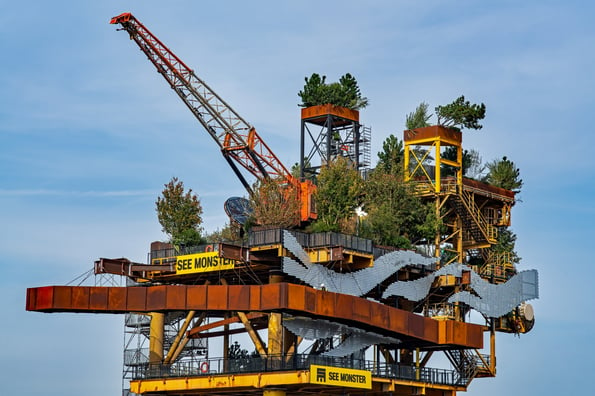2022 saw the end of one of the UK’s largest, and possibly most bizarre, public art exhibitions – an oil rig. The ‘SEE MONSTER’ started its life as a North Sea oil rig. Its original operator and exact location in the ocean went unspoken; however, thanks to the UK STEAM (science, technology, engineering, arts and maths) festival Unboxed: Creativity in the UK, its decommissioning saw all 450 tonnes and 35 meters of its topside arrive on the shoreline for a display that allowed members of the public to clamber onboard and explore this enormous structure.
The dismantling and recycling of the SEE MONSTER will now begin, and all that will eventually remain of its steel skeleton (which is being recycled in the UK) will be the photos of its spell on the Weston-Super-Mare seafront. Nevertheless, one question that will remain is what should we be doing with our retired offshore infrastructure?

The SEA MONSTER
How do you decommission an oil rig?
There are over 12000 offshore installations worldwide, and as we strive to wean ourselves off fossil fuels, an increasing number of them will be heading for decommissioning each year. The most recent estimates for the North Sea are that 2100 wells will be decommissioned in the next decade, costing up to £19.7 billion.
The Rigs-to-Reefs program, whereby the underwater structures of decommissioned oil platforms are left in the water where they can form an artificial reef to support marine life, has proven popular in the USA. However, it is controversial amongst environmentalists and banned in the North Sea at present.
One incongruous feature of the oil rig’s renovation ahead of the SEE MONSTER exhibition was the installation of 4080 watts worth of solar panels to power other elements of the exhibition. However, the juxtaposition of decommissioned oil platforms and climate tech might become a more common sight over the next decades.
The Italian oil major-turned-‘energy company’ Eni have already deployed their Inertial Sea Wave Energy Converter (ISWEC), a fully-sealed wave energy device that prevents corrosive seawater reaching its inner workings, off the coast of Ravenna for powering oil and gas platforms. Their ambitions are to develop the technology to be suitable for conversion of mature offshore platforms into renewable wave energy generation hubs.
However, it is not only wave energy that has been discussed in relation to disused platforms. There is also the possibility of using these structures as hubs to support the construction and operation of offshore wind farms. In fact, this combination could even be used to address the intermittency problem associated with so many renewable energy sources: repurposed oil platforms could store batteries, electrolysers for hydrogen generation, or other forms of energy storage, close to the point of energy generation. This would then allow the energy from the wind turbines to efficiently assist with grid balancing.
Icebergs of the North Sea
Whilst the topsides are the most visible elements of oil rigs, the reality is that that they are akin to icebergs: a large proportion of their infrastructure lies under the water. The wells into the reservoirs and the pipelines used to get the oil and gas from well to the platform and back to the shore represent enormous potential value for another industry that is on the rise: carbon dioxide removal and storage. The existing infrastructure can be used to fast-track sequestration projects for storing CO2 captured from point sources, the atmosphere, or the oceans, in the rock formations from which that oil and gas have been extracted. Project Greensands, which has recently received approval from the Danish and Belgian governments, is just one example of an oil platform connected to a depleted reservoir having its flow reversed for CO2 injection – the Nina A oil platform 200 km off the coast of Denmark will (at least for the pilot stage) be receiving CO2 captured at an Ineos Oxides plant in Belgium, with aims to eventually store 8 million tonnes of CO2 per year.
Can ocean-based carbon dioxide removal make an entrance?
There may be an even more radical option available for combining carbon capture and old oil rigs. Ocean-based carbon dioxide removal (CDR) is taking off, and if it is possible to deploy ocean-based CDR technology on these old platforms, then the costs and efficiency losses associated with transporting captured CO2 to its storage location and the provision of infrastructure for storing that CO2 could be substantially cut. Captura are already envisaging an offshore installation with an enormous ‘U’-shaped solar panel array surrounding their CO2 capture plant – just imagine an oil rig at its centre instead of their geodesic dome. The role reversal is almost poetic.
Oil and gas companies are by now used to the cries of greenwashing when they seek to involve themselves in the transition to net-zero. However, when it comes to retiring offshore oil and gas rigs, they have a serious financial incentive to back the deployment of climate tech on their platforms to help mitigate the costs associated with decommissioning. Let us hope their actions are as good as their words.
Rob is a patent attorney in our engineering and ICT team. Rob has an MEng degree in Chemical Engineering from the University of Cambridge. His masters research project focussed on three-dimensional analysis of particle-size segregation within granular avalanches using magnetic resonance imaging. During his undergraduate studies, Rob spent time working for Proctor & Gamble within their Baby-Care R&D Group.
Email: rob.walker@mewburn.com

-1.png)
